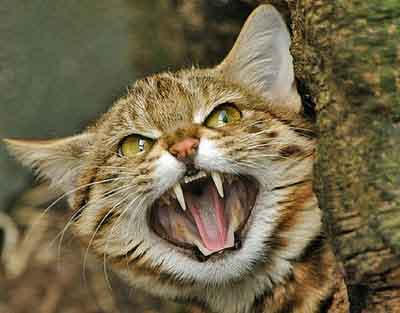
Black-footed cat. Photo by ‘guppiecat’.
Overview
The name of this diminutive cat, the smallest African cat species, is slightly misleading as the paw pads and undersides of the feet are black but nothing else. Attempts to rename the cat failed. This secretive wild cat is found in the south west corner of the African continent. It mainly feeds on mice, shrews and gerbils. The black-footed cat lives in a dry open landscape but despite that, they are very successful hunters (60% success rate). The scientific name is Felis nigripes. Other names for this cat are:
- Little Spotted Cat
- Small Spotted Cat
- Sebala Cat (local)
- Bont-kat (local)
- Miershooptier (Africaans for “anthill” tiger, after the fact that they sometimes burrow and live in termite mounds)
Longer overview of this cat species
Conservation
I would like to emphasize conservation of this rare cat, the most important topic for all wild cats. The black-footed cat is listed in Appendix I of CITES. Appendix I lists species that are the most endangered among CITES listed animals and plants. This wildcat is listed as vulnerable in the IUCN Red List of Threatened Species™ (formerly Least Concern). Vulnerable is in the upper mid range of threatened wild species and indicates that this cat’s survival in the wild is threatened.


Black footed cat photo by corwinok

Both the above links shows us the status of this cat in terms of its survival in the wild. On a scale of 1-10 this cat is at about 5 in terms of its survival. There are no pictures of this cat in the wild that are available for publication as far as I am aware. I keep banging away, but projections as to future survival in the wild of this cat cannot be good. The Red List™ status is getting worse and Appendix I CITES is as bad as it gets. It is no good simply recording the status. Long term strategies need to be formulated to preserve this species and that starts with the question, “do we care”? By “we” I mean the people on the ground in the countries of this cat’s habitat (see below). They are the people who are at the sharp end and responsible.
Description

Photo copyright: Anne-Marie Kalus – see more
See Black-footed cat description.
It is the smallest of the African wildcats. This wildcat looks like a small tabby domestic cat. In the above photograph you could not spot the difference (almost – there is always the coarser more functional nature of the fur, for example). This is a small wild cat with black paw pads, hence the name (see photo above). It is not the only wildcat with black feet. The African wildcat has them too. The cat’s size is that of a domestic miniature cat at about 2.9 lbs for females and 4.2 lbs for males averaging 3.5 lbs, which is small even for a domestic cat. See a comparison of domestic cat sizes to wild cat sizes. The rusty spotted cat is another small wildcat of similar small size. On the linked page, you can see a chart and some more numbers about wild cat species by size.
The coat is a spotted tabby with banding on the legs, the natural markings for a wildcat as it offers the best camouflage. It is also probably the most common coat type for domestic cats. Interestingly, the skin is pink throughout.

pic
I recently found a Domesticated Black-Footed Adult Female with four kittens in tow living in my neighbor’s abandoned shed. I was wondering if these ‘cross-breeds’ are a rarity, or just your run-of-the-mill domestic feline–only because they all will be in need of adoption just as soon as the kittens are old enough. Thanks,
Vincent
Hi Vincent. The domesticated cats you refer to are semi-domesticated random bred cats with black paw pads and fur around the pads, I guess, just like the wild cat species the black-footed cat but they are not wild cat hybrids in my opinion. There are no known examples of black-footed wild cat hybrids and they only live in Africa. I guess someone could have imported one or two and tried to mate them with a domestic cat. That is a possibility but it is far more likely that the cat in the photo is a handsome tabby cat with black feet. Thanks for sharing.